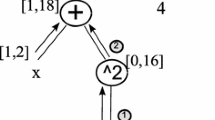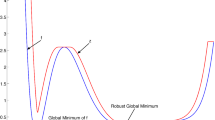Abstract
Interval analysis is a powerful tool which allows to design branch-and-bound algorithms able to solve many global optimization problems. In this paper we present new adaptive multisection rules which enable the algorithm to choose the proper multisection type depending on simple heuristic decision rules. Moreover, for the selection of the next box to be subdivided, we investigate new criteria. Both the adaptive multisection and the subinterval selection rules seem to be specially suitable for being used in inequality constrained global optimization problems. The usefulness of these new techniques is shown by computational studies.
Similar content being viewed by others
References
Berner, S.: New results on verified global optimization. Computing 57, 323–343 (1996)
Casado, L.G.: Optimización global basada en aritmética de intervalos y ramificación y acotación: paralelización, Ph.D. Thesis, University of Málaga, Spain (in Spanish), 1999
Casado, L.G., García, I.: New load balancing criterion for a parallel interval global optimization algorithms, Proceedings of the 16th IASTED International Conference, Garmisch-Partenkirchen, Germany, 1998, pp. 321–323
Casado, L.G., García, I., Csendes, T.: A new multisection technique in interval methods for global optimization. Computing 65, 263–269 (2000)
Casado, L.G., García, I., Csendes, T.: A heuristic rejection criterion in interval global optimization algorithms. BIT 41, 683–692 (2001)
Casado, L.G., Martínez, J.A., García, I.: Experimenting with a new selection criterion in a fast interval optimization algorithm. J. Global Optimization 19, 247–264 (2001)
Csallner, A.E.: Global optimization in separation network synthesis. Hungarian J. Industrial Chemistry 21, 303–308 (1993)
Csallner, A.E., Csendes, T.: On the convergence speed of interval methods for global optimization. Computers, Mathematics and Applications 31, 173–178 (1996)
Csallner, A.E., Csendes, T., Markót, M.Cs.: Multisection in interval branch–and–bound methods for global optimization I. Theoretical results. J. Global Optimization 16, 371–392 (2000)
Csendes, T.: Optimization methods for process network synthesis –- a case study. In: Christer Carlsson, Inger Eriksson (eds.), Global and multiple criteria optimization and information systems quality, Abo Academy, Turku, 1998, pp. 113–132
Csendes, T.: New subinterval selection criteria for interval global optimization. J. Global Optimization 19, 307–327 (2001)
Csendes, T., Klatte, R., Ratz, D.: A posteriori direction selection rules for interval optimization methods. Central European J. Oper. Res. 8, 225–236 (2000)
Csendes, T., Pintér, J.: The impact of accelerating tools on the interval subdivision algorithm for global optimization. European J. Oper. Res. 65, 314–320 (1993)
Csendes, T., Ratz, D.: A review of subdivision direction selection in interval methods for global optimization. ZAMM 76, 319–322 (1996)
Csendes, T., Ratz, D.: Subdivision direction selection in interval methods for global optimization. SIAM J. Numerical Analysis 34, 922–938 (1997)
Drezner, Z.: Facility location: a survey of applications and methods. Springer-Verlag, Berlin, 1995
Fernández, J., Fernández, P., Pelegrín, B.: A continuous location model for siting a non-noxious undesirable facility within a geographical region. European J. Operational Res. 121, 259–274 (2000)
Fernández, J., Fernández, P., Pelegrín, B.: Estimating actual distances by norm functions: a comparison between the l k , p ,θ-norm and the l b 1 , b 2 ,θ-norm and a study about the selection of the data set. Comput. Oper. Res. 29, 609–623 (2002)
Fernández, J., Pelegrín, B.: Using interval analysis for solving planar single-facility location problems: new discarding tests. J. Global Optimization 19, 61–81 (2001)
Goos, A., Ratz, D.: Praktische Realisierung und Test eines Verifikationsverfahrens zur Lösung globaler Optimierungsprobleme mit Ungleichungsnebenbedingungen, Forschungsschwerpunkt Computerarithmetik, Intervallrechnung und Numerische Algorithmen mit Ergebnisverifikation, technical report (available at http://www.uni-karlsruhe.de/~iam/html/reports.html), 1997
Hammer, R., Hocks, M., Kulisch, U., Ratz, D.: C++ Toolbox for verified computing. Springer-Verlag, Berlin, 1995
Hansen, E.: Global optimization using interval analysis – the multidimensional case. Numerische Mathematik 34, 247–270 (1980)
Hansen, E.: Global optimization using interval analysis. Marcel Dekker, New York, 1992
Horst, R., Pardalos, P.M. (eds.): Handbook of global optimization. Kluwer, Dordrecht, 1995
Horst, R., Tuy, H.: Global optimization. Deterministic approaches. Springer-Verlag, Berlin, 1996
Hua, J.Z., Brennecke, J.F., Stadtherr, M.A.: Enhanced interval analysis for phase stability: cubic equation of state models. Industrial Engineering Chemical Research 37, 1519–1527 (1998)
Kearfott, R.B.: Rigorous global search: continuous problems. Kluwer, Dordrecht, 1996
Kearfott, R.B.: Test results for an interval branch and bound algorithm for equality-constrained optimization, in: State of the art in global optimization, Kluwer, Dordrecht, pp. 181–199, 1996
Kearfott, R.B.: On verifying feasibility in equality constrained optimization problems, technical report (available at http://interval.louisiana.edu/preprints.html), 1996
Kearfott, R.B.: On proving existence of feasible points in equality constrained optimization problems. Math. Program. 83, 89–100 (1998)
Klatte, R., Kulisch, U., Wiethoff, A., Lawo, C., Rauch, M.: C-XSC – A C++ class library for extended scientific computing. Springer-Verlag, Heidelberg, 1993
Knüppel, O.: PROFIL/BIAS –- a fast interval library. Computing 53, 277–287 (1994)
Love, R.F., Morris, J.G., Wesolowsky, G.O.: Facilities location: models and methods. North-Holland, New York, 1988
Markót, M.Cs.: An interval method to validate optimal solutions of the “packing circles in a unit square” problems. Central European J. Oper. Res. 8, 63–78 (2000)
Markót, M.Cs., Csendes, T., Csallner, A.E.: Multisection in interval branch-and-bound methods for global optimization. II. Numerical tests. J. Global Optimization 16, 219–228 (2000)
Ratschek, H., Rokne, J.: Computer methods for the range of functions. Ellis Horwood, Chichester, 1984
Ratschek, H., Rokne, J.: New computer methods for global optimization. Ellis Horwood, Chichester, 1988
Ratschek, H., Rokne, J.: Experiments using interval analysis for solving a circuit design problem. J. Global Optimization 3, 501–518 (1993)
Ratschek, H., Voller, R.L.: What can interval analysis do for global optimization?. J. Global Optimization 1, 111–130 (1991)
Ratz, D.: Box-splitting strategies for the interval Gauss-Seidel step in a global optimization method. Computing 53, 337–353 (1994)
Ratz, D.: On branching rules in second-order branch-and-bound methods for global optimization. In: G. Alefeld, A. Frommer, B. Lang (eds.), Scientific computing and validated numerics, Akademie-Verlag, Berlin, 1996, pp. 221–227
Ratz, D., Csendes, T.: On the selection of subdivision directions in interval branch-and-bound methods for global optimization. J. Global Optimization 7, 183–207 (1995)
Vaidyanathan, R., El-Halwagi, M.: Global optimization of nonconvex nonlinear programs via interval analysis. Computers & Chemical Engineering 18, 889–897 (1994)
Author information
Authors and Affiliations
Corresponding author
Rights and permissions
About this article
Cite this article
Markót, M., Fernández, J., Casado, L. et al. New interval methods for constrained global optimization. Math. Program. 106, 287–318 (2006). https://doi.org/10.1007/s10107-005-0607-2
Received:
Accepted:
Published:
Issue Date:
DOI: https://doi.org/10.1007/s10107-005-0607-2
Keywords
- Global optimization
- Inequality constrained problems
- Interval analysis
- Adaptive multisection
- Subinterval selection criterion
- Computational study




